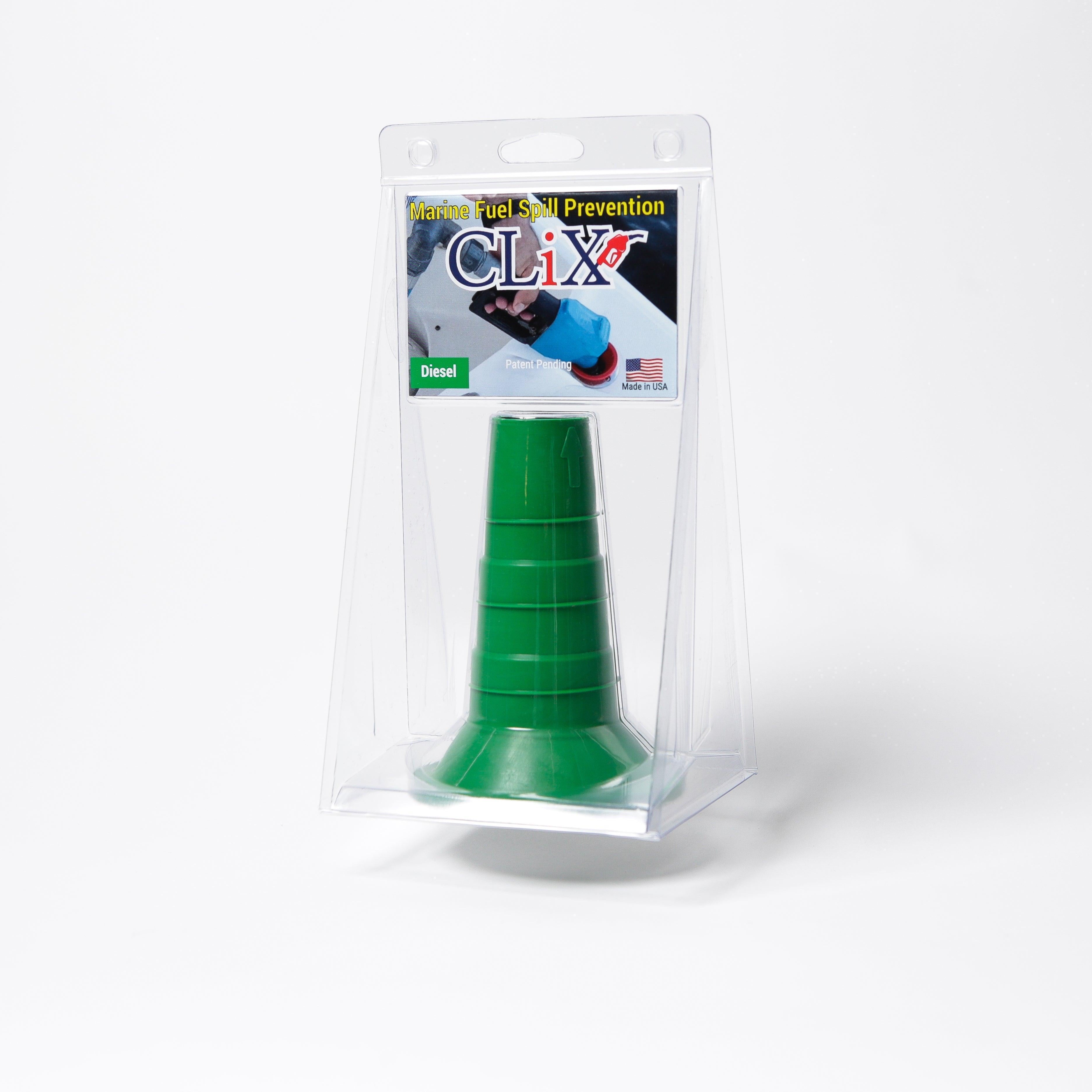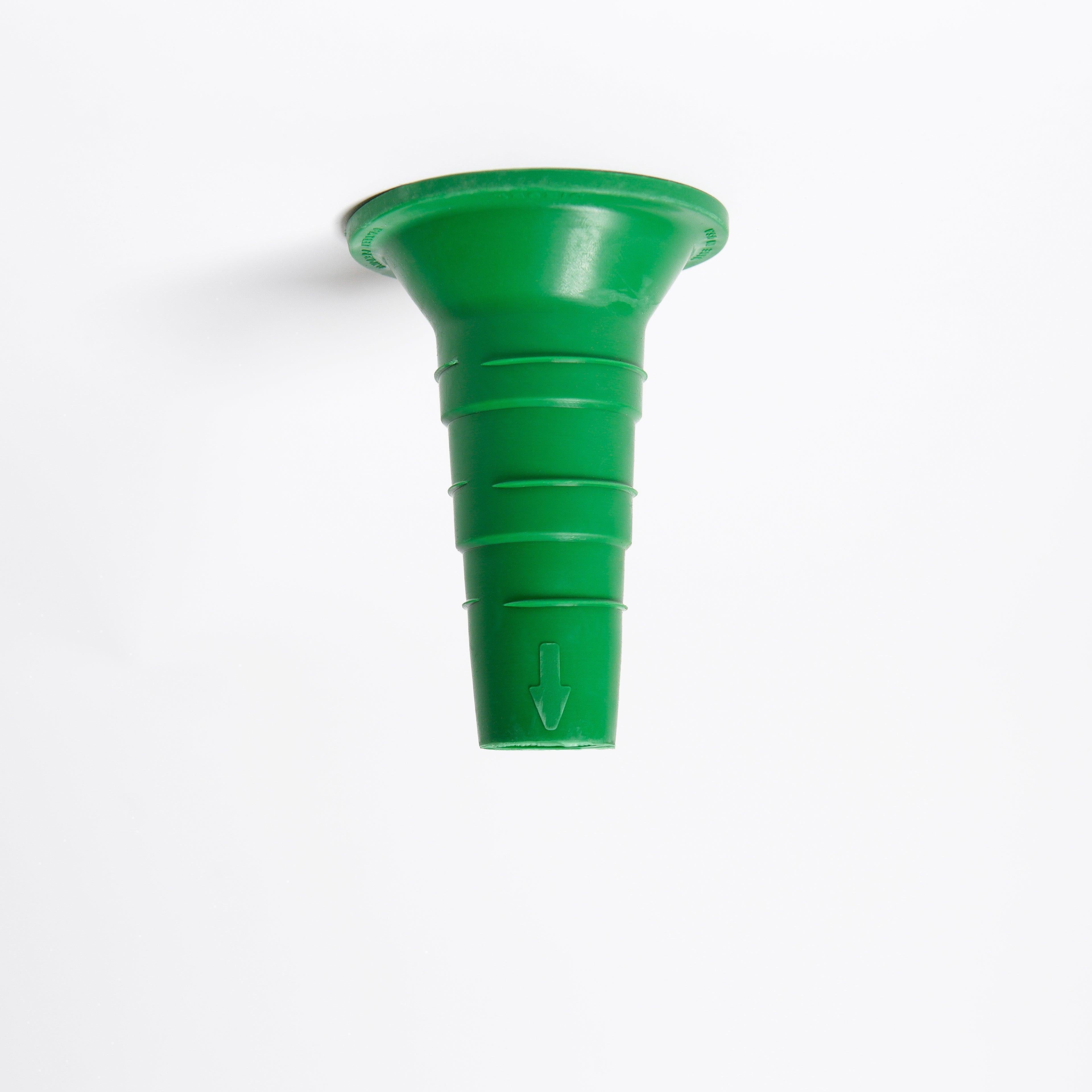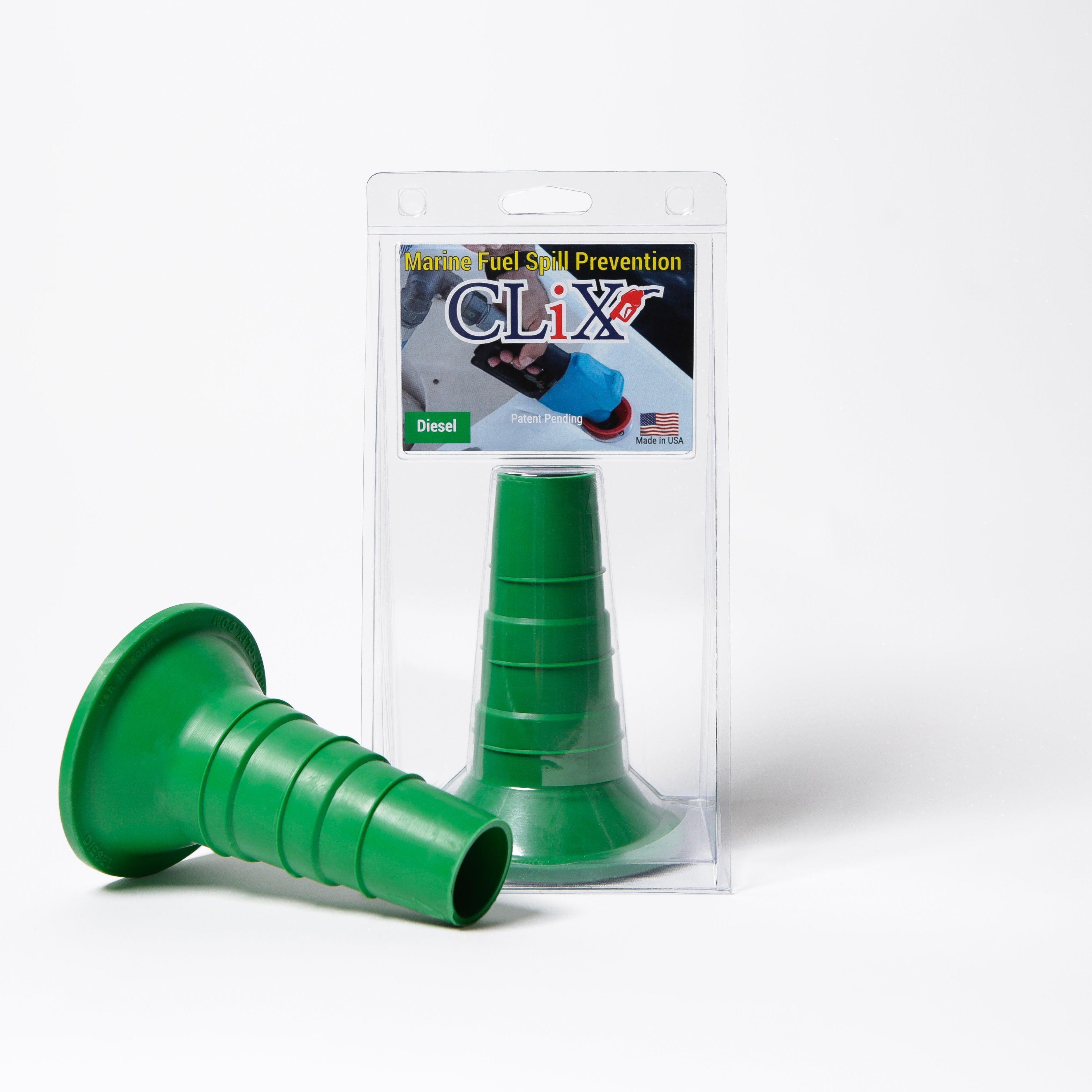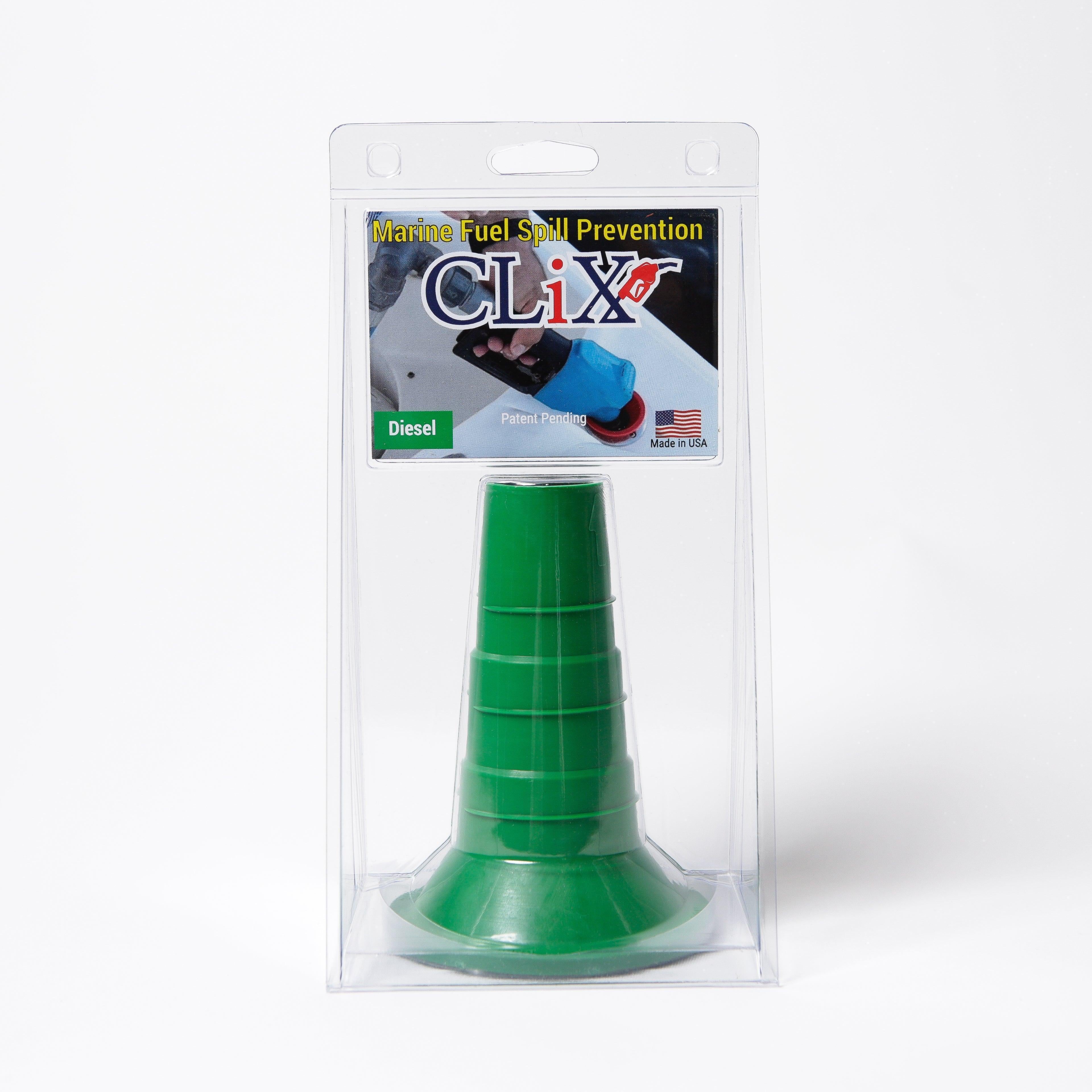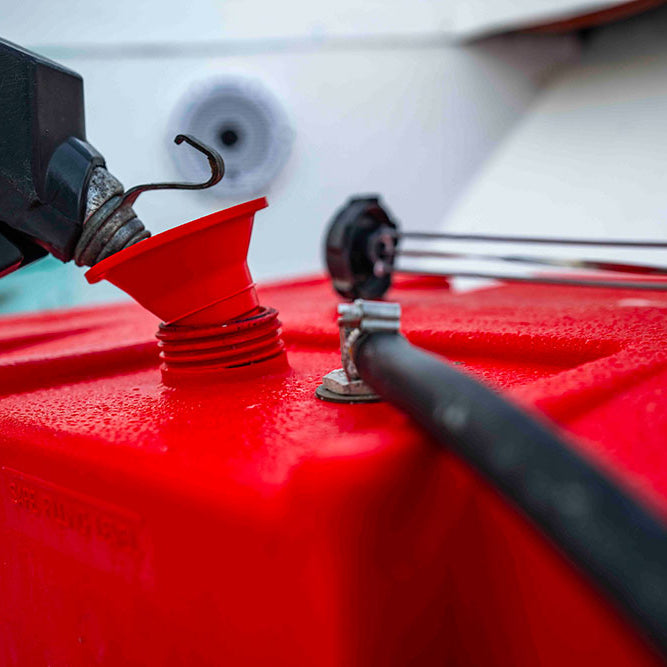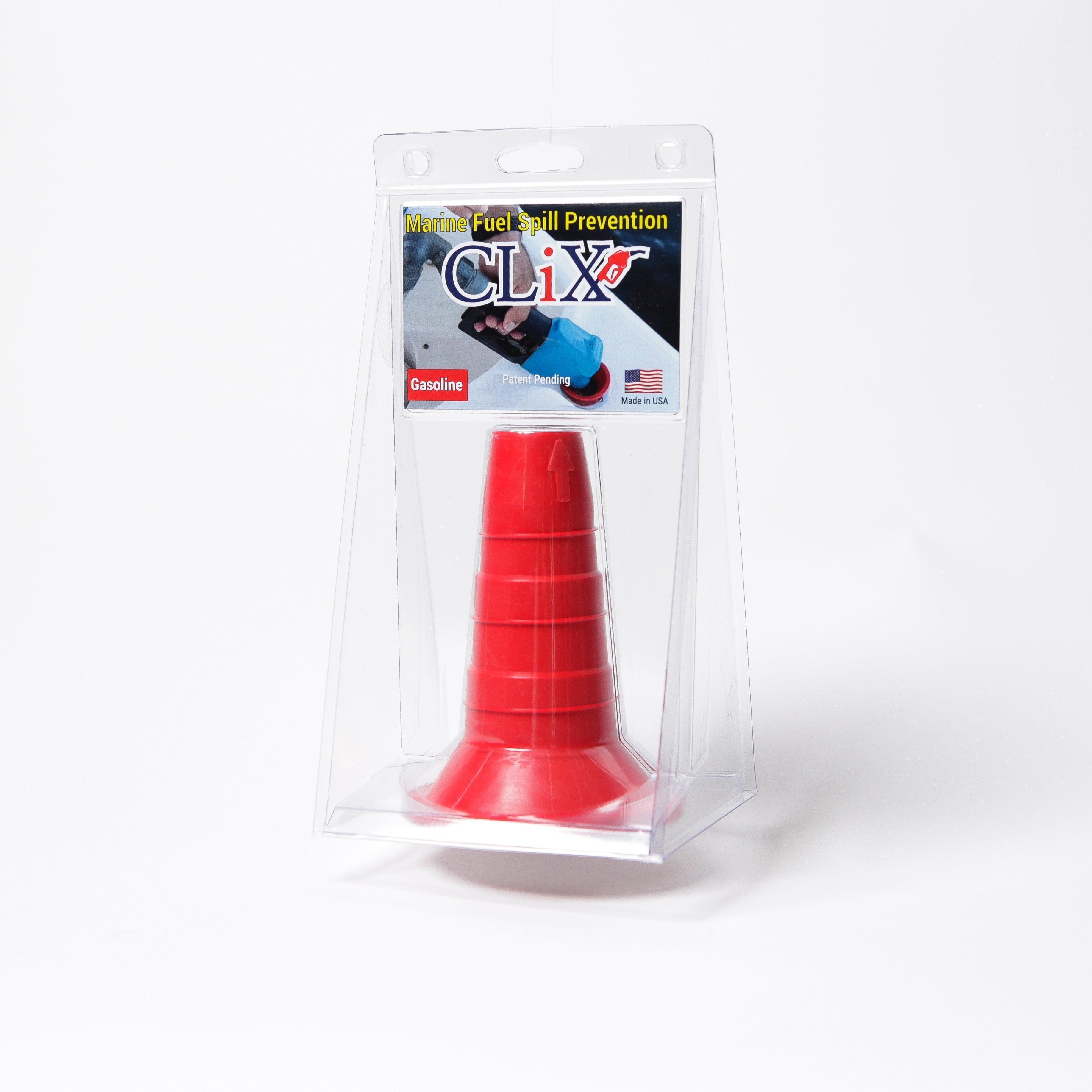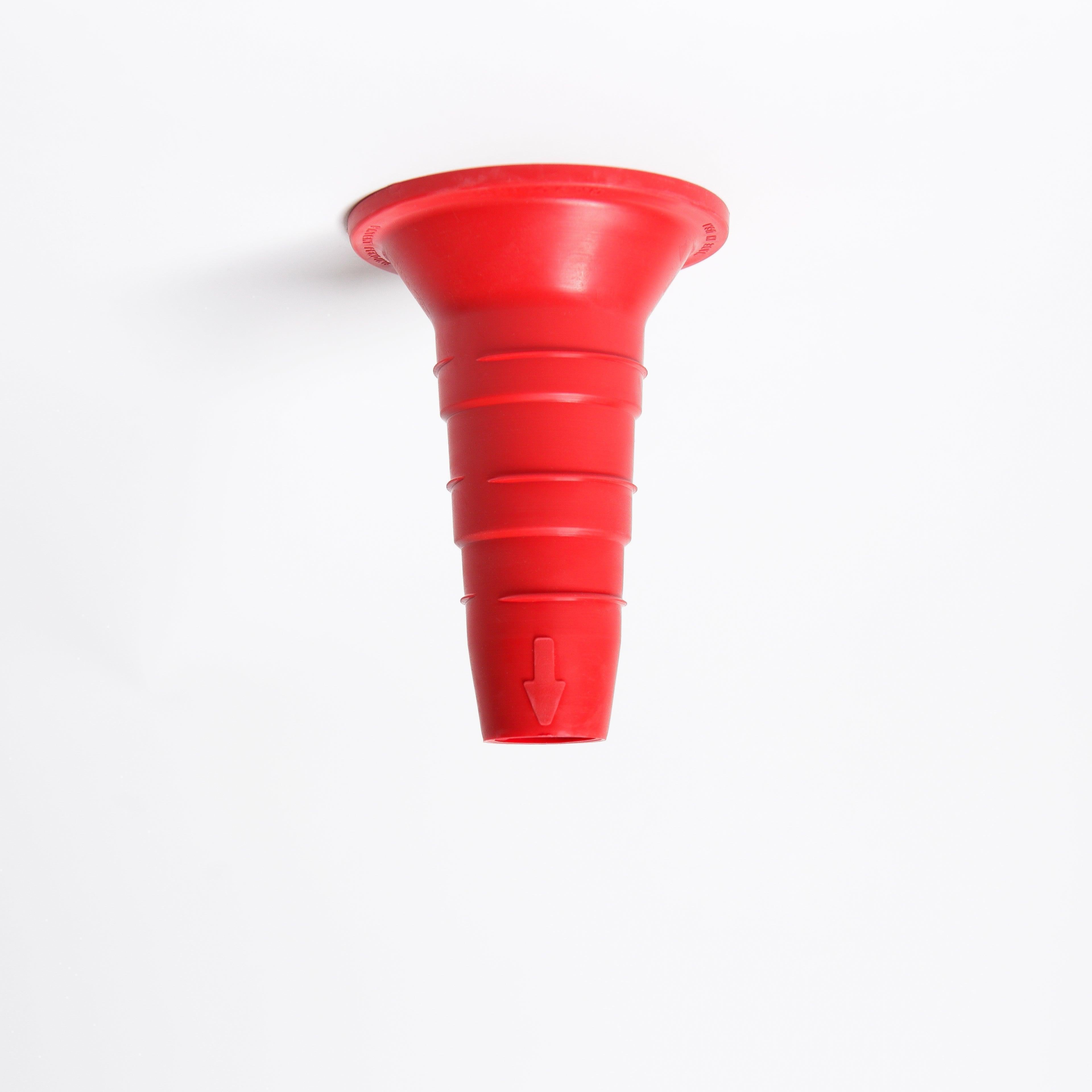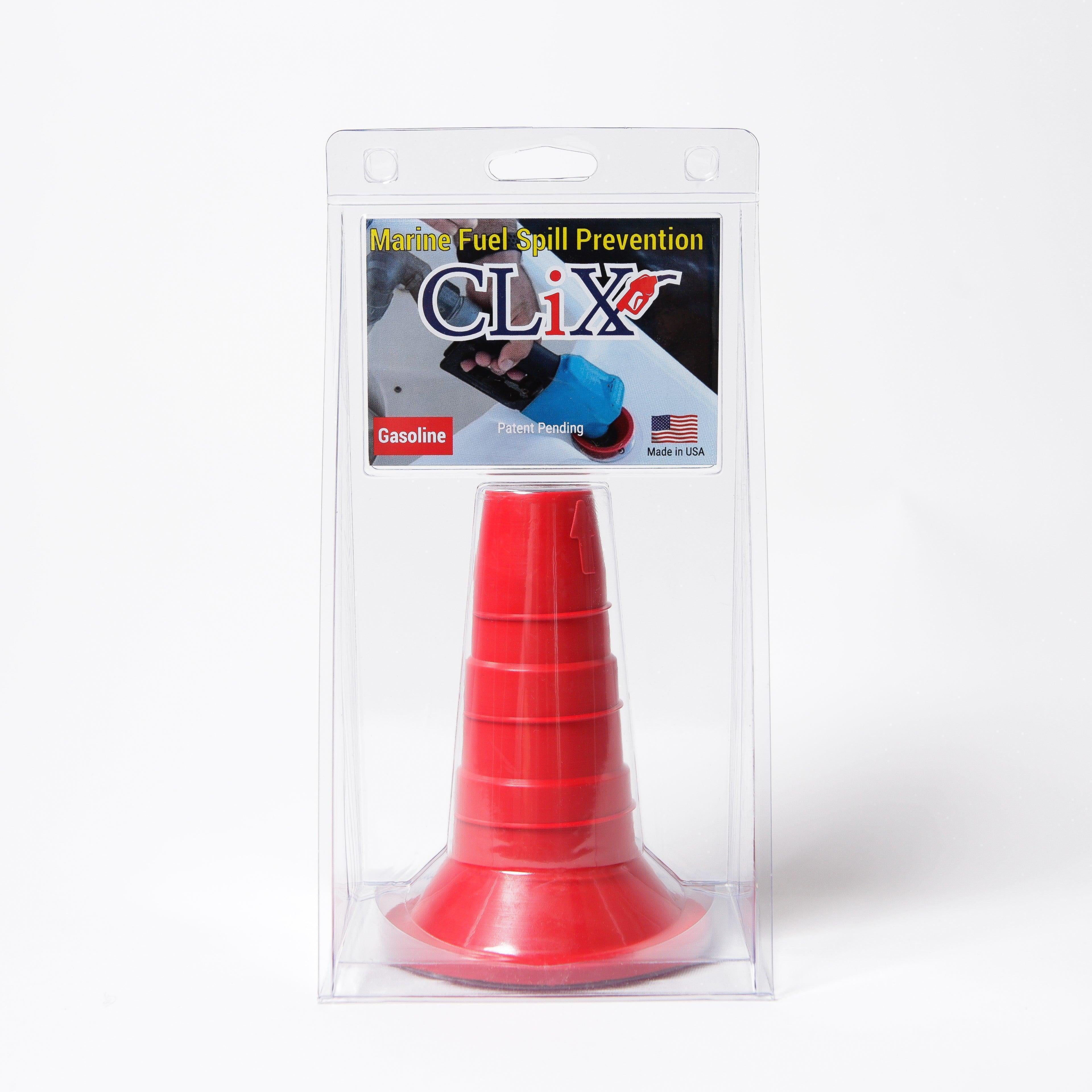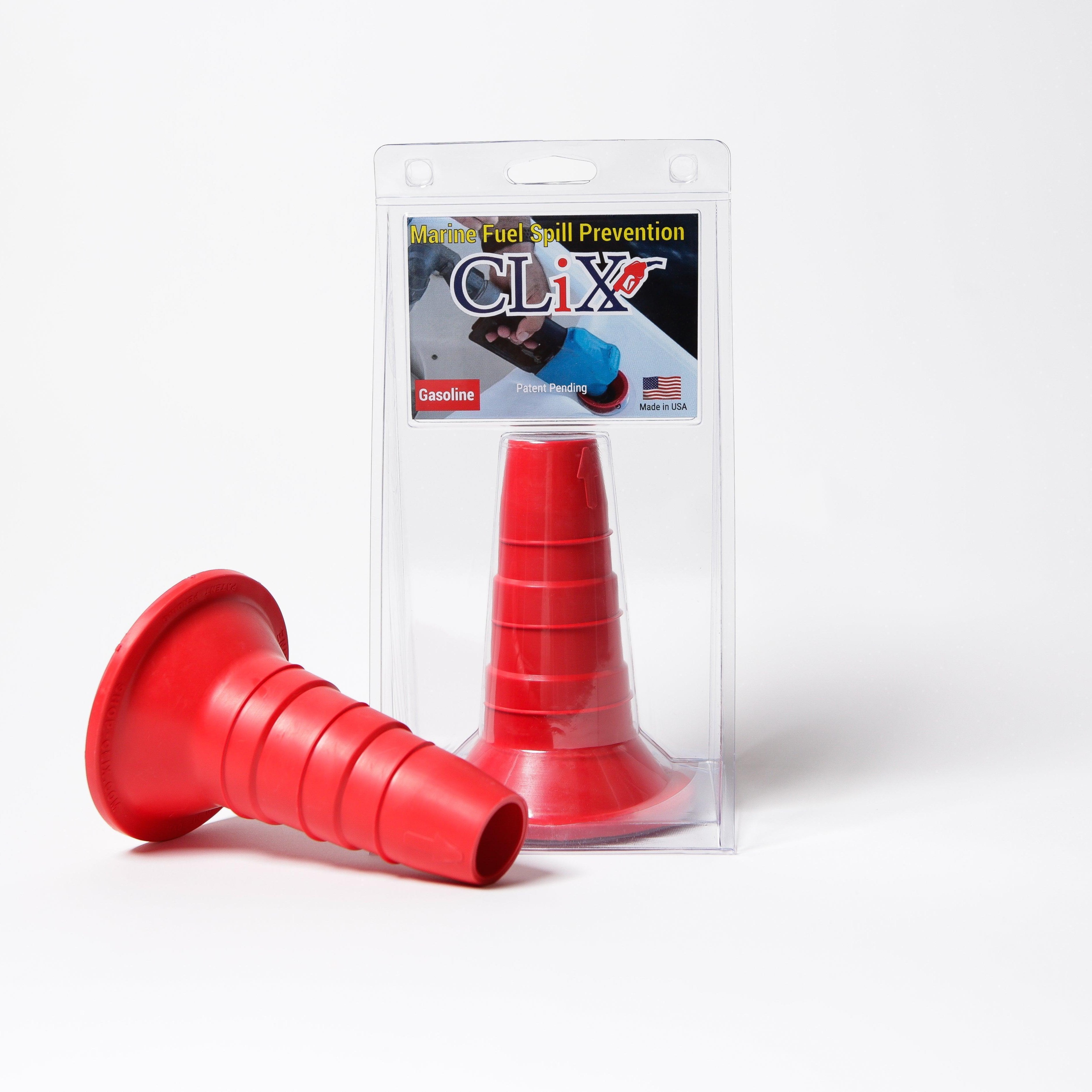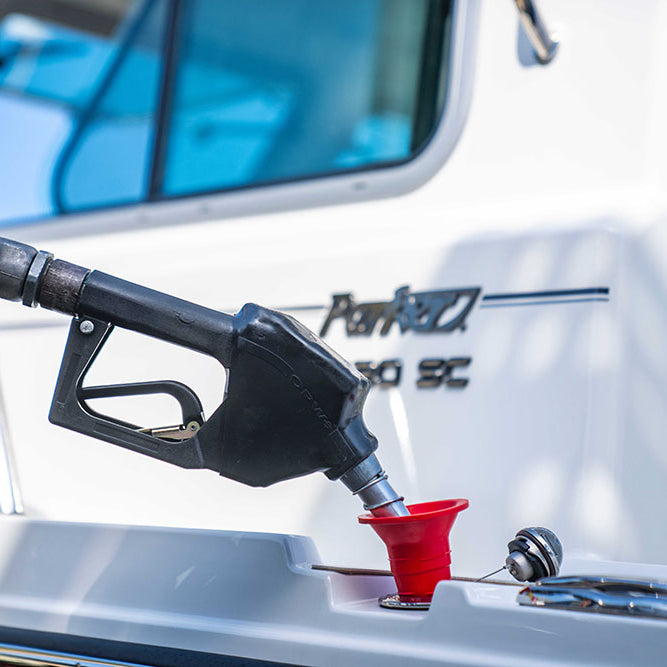Refueling your boat is one of those routine tasks that's easy to get complacent about, but it's genuinely one of the most critical safety procedures you'll ever perform. Getting it right isn't just about topping off the tank; it's about protecting yourself, your passengers, and the water you love from preventable accidents like fires and spills.
Think of it less as a chore and more as a skill. Once you understand what's really at stake, you’ll approach the fuel dock with the focus and respect it deserves.
Why a Safe Boat Fuel Fill Is So Important
We’ve all seen it happen at the fuel dock. Someone gets distracted by a phone call or a chat, the nozzle clicks off, but they keep squeezing, and suddenly fuel is spewing out of the overflow vent. It runs down the side of the boat, staining the gelcoat and leaving a rainbow sheen on the water. That common mistake isn't just messy—it's incredibly dangerous.
The Dangers You Can't Always See
The real hazards of fueling are often the invisible ones. Gasoline vapors are the true culprit. They’re heavier than air, so they can quickly settle in the lowest parts of your boat, like the bilge or engine compartment, creating a ticking time bomb.
- A Spark Is All It Takes: The friction from fuel flowing through a hose or even the static on your clothes can generate enough of a spark to ignite those fumes. This is exactly why you must maintain constant metal-to-metal contact between the fuel nozzle and the boat’s fuel fill. It creates a ground and safely neutralizes any static buildup.
- The Silent Threat of Fumes: You can't see fuel vapor, which makes it particularly sneaky. It pools in confined spaces, just waiting for an ignition source. Starting your engine, flipping a switch, or even a stray spark from a battery connection can trigger a violent explosion. This is why running your bilge blower for at least four minutes before you even think about turning the key is non-negotiable.
Understanding these risks isn't about being scared; it's about being smart. When you master a safe fueling process, it becomes second nature—a fundamental part of being a responsible boater.
A few extra minutes of careful attention at the dock is a small price to pay for peace of mind. It ensures your day on the water is memorable for all the right reasons, protecting your boat, your crew, and the beautiful marine environment we all share.
Your Pre-Fueling Safety Checklist
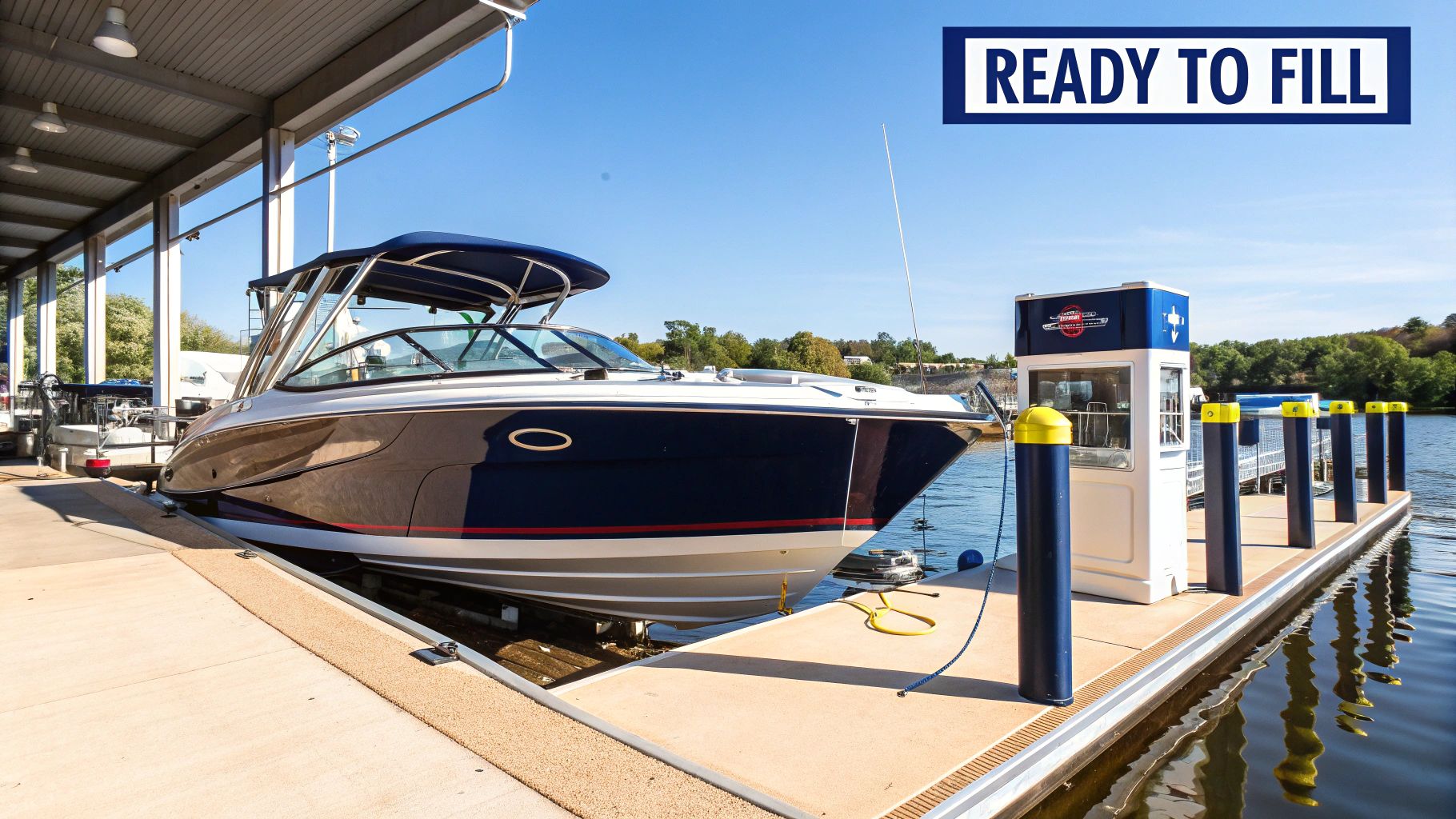
Before you even think about picking up that fuel nozzle, take a few minutes for a simple routine. I’ve seen it time and again—a quick series of checks is what separates a smooth, safe fill-up from a dangerous, costly mess. Think of it like a pilot's pre-flight checklist. It's not optional. It’s what the pros do every single time to ensure a safe boat fuel fill.
Your prep work starts the second you tie up. Get your boat moored securely to the dock. You don't want it shifting or drifting while you’ve got a fuel line attached. Once you’re tied off, have everyone who isn’t helping with the fueling step off onto the dock. It keeps them safe and clears your workspace.
Next, kill any and all potential flames. That means absolutely no smoking anywhere near the boat, shutting down the galley stove, and making sure the BBQ is cold. You're creating a strict no-ignition zone.
Eliminate All Electrical Ignition Sources
This next part is the most important step, and it's where people often get complacent. You have to shut down all electrical power. I can't stress this enough. Gasoline vapors are heavier than air and can settle in low spots, just waiting for a single stray spark to ignite.
Here’s your quick electrical shutdown list. Do it in this order, every time:
- Engine Off: The first and most obvious step.
- Electronics Off: Shut down everything—radios, navigation screens, cabin lights, the stereo. Everything.
- Main Battery Switch Off: This is the kill shot. Flipping the main battery switch ensures there’s no stray current anywhere on board that could create a spark.
Finally, button up the boat. Close every porthole, hatch, and window. This prevents those heavy fuel fumes from finding their way below deck and collecting in the bilge or cabin, which is a recipe for disaster.
A safe fueling process is built on this foundation. Taking these few minutes to prepare doesn't just reduce risk—it practically eliminates the common causes of fueling-related fires and explosions.
This preparation becomes even more critical when you consider the money on the line. A single fill-up for a medium-sized yacht can easily run between $5,000 to $20,000, with bigger boats costing upwards of $200,000 at the pump. Protecting that asset starts right here. Get familiar with your vessel's unique systems by checking out our boat fuel tank guide for safety and maintenance to round out your knowledge.
Executing the Perfect Fuel Fill
With all your prep work done, it's time for the main event—actually getting the fuel into the tank. This is where a steady hand and a bit of technique make all the difference, ensuring a safe, spill-free fill-up.
First things first, take a moment to double-check that you've grabbed the correct nozzle—gasoline or diesel. Then, confirm you're about to put it into the fuel fill, not the freshwater tank or a rod holder. It sounds obvious, but you’d be surprised how often this mistake happens at the dock.
Once you’re sure, insert the fuel nozzle firmly into the deck fitting. It's crucial to maintain continuous metal-to-metal contact between the nozzle and your boat's fill pipe. This small action is a big deal; it grounds the connection and prevents static electricity from building up, which could create a dangerous spark. Keep a firm grip on it the entire time.
Listening for the Right Cues
Now, start pumping at a slow, deliberate pace. Trying to set a speed record is the fastest way to make a messy, dangerous mistake.
Instead of just watching the fuel gauge—which can often be unreliable—use your ears. As the tank starts to fill, you’ll hear the sound change. That hollow echo will become a higher-pitched gurgling or bubbling. This is your most dependable signal that the tank is getting close to full.
This simple flow chart drives home the point that a safe fill is all about a controlled, mindful process.
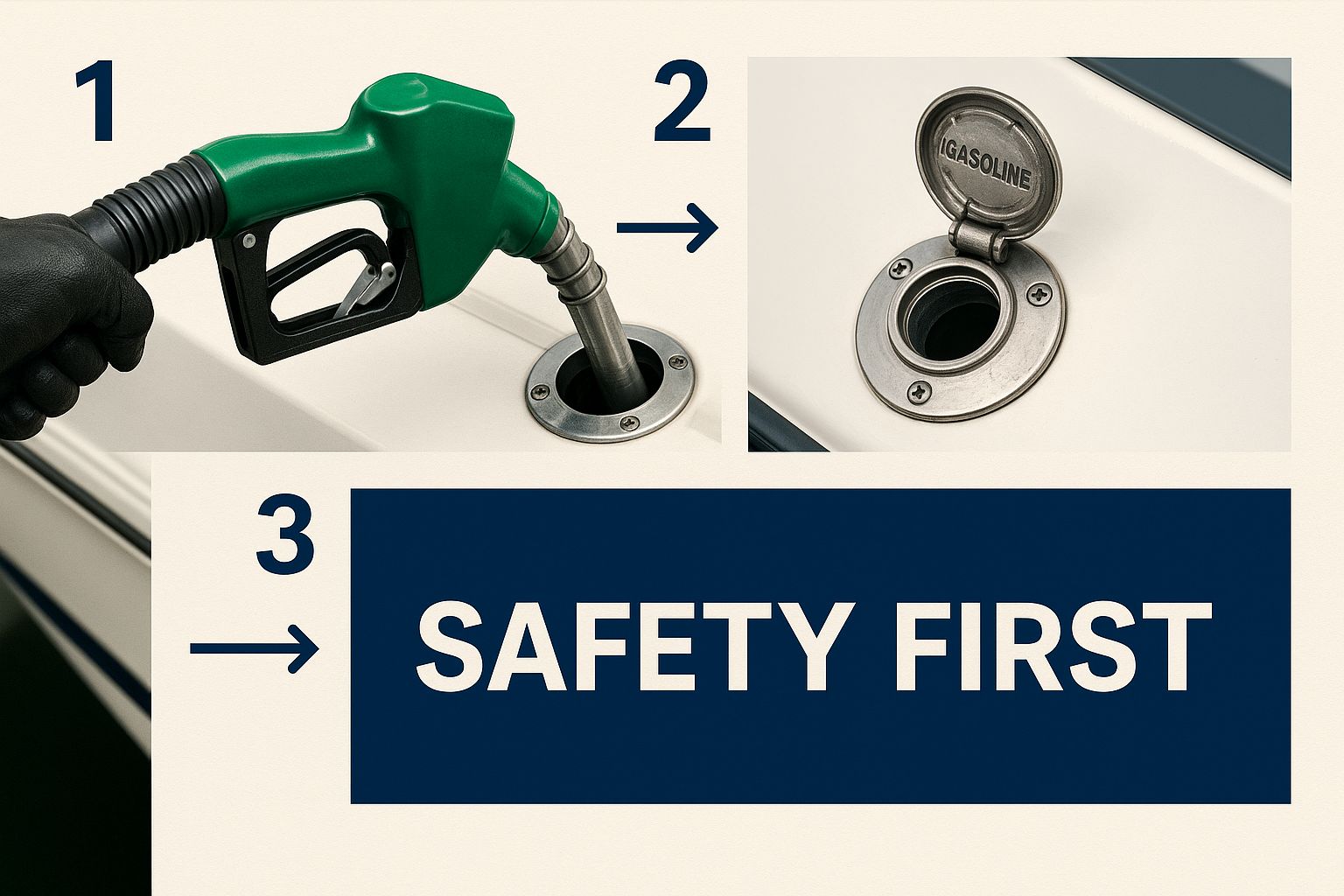
The single most important rule to remember? Never fill your tank beyond 90% capacity. This isn't just a friendly tip; it's a vital safety standard. Fuel expands with heat. If you fill the tank to the brim on a hot day, that expanding fuel has nowhere to go but out the vent line and into the water. Leaving that 10% buffer protects the environment, your boat's gelcoat, and your wallet.
Experienced boaters know that a perfect fuel fill isn't about cramming every last drop into the tank. It’s about getting the right amount in safely, leaving a 10% buffer for expansion and peace of mind.
This mindful approach is more important than ever. Back in 2012, marine vessels consumed about 300 million tonnes of fuel annually, a number that underscores our shared responsibility to handle fuel with care. You can learn more about worldwide marine fuel trends in this factsheet on global marine fuel consumption.
Gas vs. Diesel Fueling Checklist
While the core principles are the same, there are subtle but important differences between fueling a gasoline and a diesel boat. This quick checklist is a handy reminder of what to focus on for each fuel type.
| Checklist Item | Gasoline (Petrol) | Diesel |
|---|---|---|
| Ventilation is Key | Crucial. Turn on blowers for several minutes before and after. Open all hatches. | Recommended. Fumes are less volatile, but good airflow is always a smart practice. |
| Spark & Ignition Risk | Very High. Fumes are highly flammable. No smoking, no open flames. | Lower Risk. Diesel has a much higher flash point, but all ignition sources should still be eliminated. |
| Static Electricity | Critical. Always maintain metal-to-metal nozzle contact. | Critical. The risk is lower but still present. Maintain contact. |
| Spill Cleanup | Use absorbent pads immediately. Fumes can linger. | Clean up with pads. Diesel is oily and can stain surfaces quickly. |
| "90% Full" Rule | Essential. Gas expands significantly with heat. | Essential. Diesel also expands; the 10% buffer is just as important. |
Using this checklist helps reinforce good habits every time you visit the fuel dock, no matter what kind of engine your boat has. It's about building muscle memory for safety.
Final Checks After You've Fueled Up
Just because the fuel cap is back on doesn't mean you're ready to hit the water. What you do after you've filled the tank is just as important for safety as the fueling itself. Your first job is to clean up any mess.
It's easy for a few drips to escape, no matter how careful you are. Grab an oil-absorbent pad—not just a shop towel—and wipe down any fuel you see on the deck or near the fill. Remember, that used pad is now hazardous waste, so don't just chuck it in the nearest trash can. It needs to go into a proper disposal container at the marina.
Clearing the Air Is Non-Negotiable
With the boat wiped down, it's time for the most critical post-fueling step: ventilation. Gasoline fumes are heavier than air, which means they can sink and collect in your bilge. This creates a serious explosion risk you can't even see.
If you have a gasoline engine, you absolutely must run your bilge blower for at least four to five minutes. No shortcuts here. The whole point is to completely cycle the air out of the engine bay and get rid of any fumes that might have snuck in while you were fueling.
Before you even think about turning that key, rely on the oldest and most effective tool in a boater's safety kit: your nose. After the blowers have done their job for a few minutes, open up the engine compartment hatch. Stick your head in there and take a good, deliberate sniff down low near the bilge. It's a surprisingly sensitive way to detect gas vapors.
You need to be 100% certain the air is clear. If you catch even the slightest whiff of gasoline, something's not right. Keep the blowers running, and don't touch any electronics or start the engine until you've figured out where that smell is coming from. For a deeper dive, check out our complete boat fueling safety playbook.
The amount of fuel being moved around the world is staggering. As of April 2025, the global ship orderbook alone required 40.5 million metric tonnes of bunker fuel, with traditional oil still being the primary choice. This just goes to show how crucial it is for every single boater to take fuel handling seriously. You can see a full breakdown of bunker fuel demand trends to get the bigger picture.
Common Fueling Mistakes and How to Avoid Them
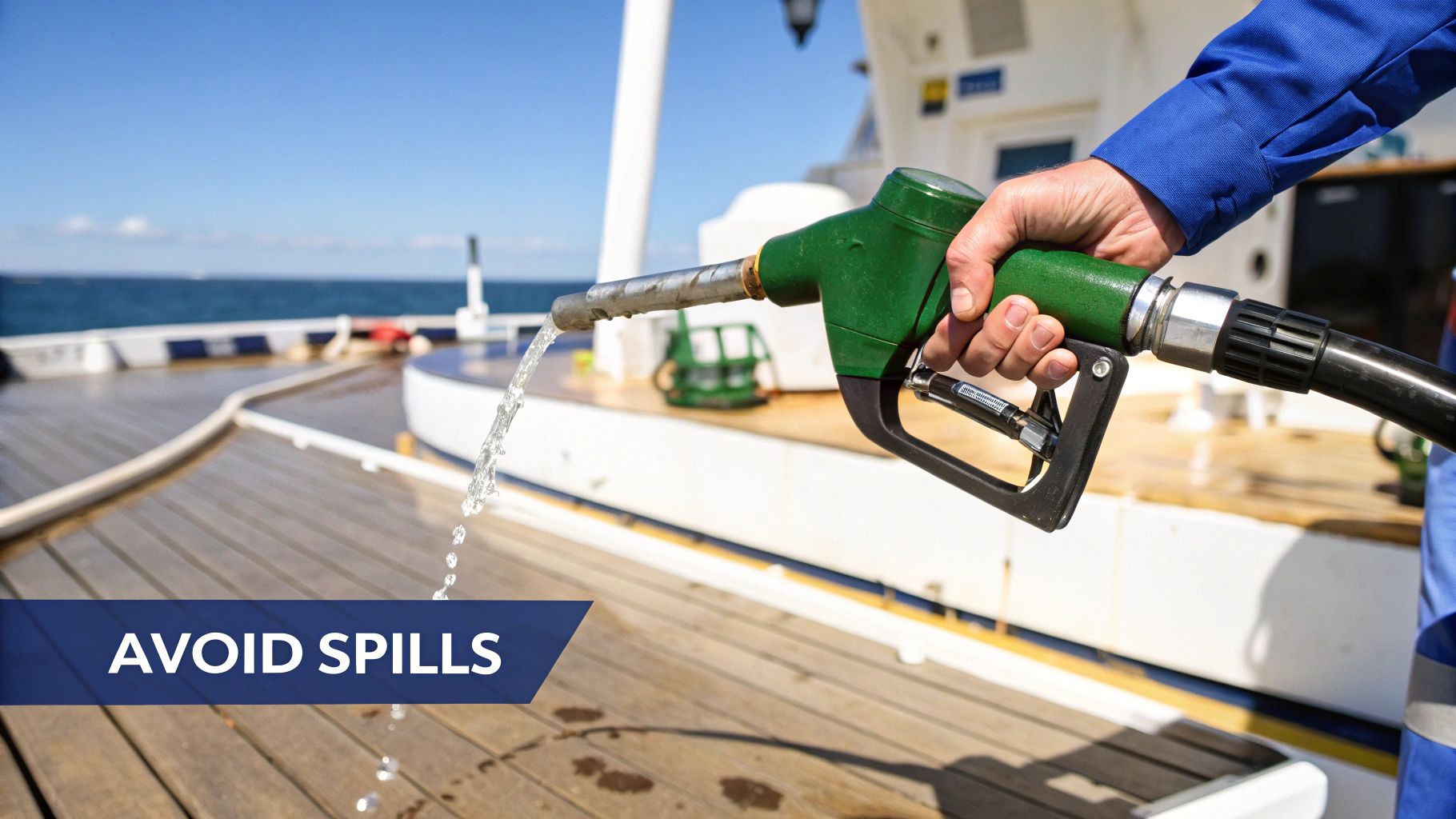
We've all heard the horror stories from the fuel dock. Truth is, learning from someone else's mistake is a whole lot cheaper and safer than making it yourself. Even boaters with decades of experience can have a momentary lapse in focus that turns into a dangerous, expensive mess.
Let's walk through a few real-world blunders so you can sidestep them entirely.
Picture this: you're used to your car's green pump handle being for gasoline, so you grab the green one at the marina out of habit. The problem? You've just started pumping diesel into your gasoline engine. That one mistake can easily lead to thousands in engine repairs. An equally common—and cringe-worthy—mix-up is putting the fuel nozzle into the freshwater fill. Now your entire water system is contaminated.
The most expensive lesson is often the one you learn firsthand. A moment of distraction at the fuel dock can lead to a ruined weekend, thousands in repairs, or a serious environmental spill.
Another classic pitfall is putting all your trust in the fuel gauge. Let's be honest, boat fuel gauges are notoriously fickle and can fail without any warning. Relying solely on that needle is a surefire way to cause a major overfill, spilling fuel all over your deck and into the water. The cleanup fines and potential gelcoat damage are just not worth the risk.
The Most Common—and Dangerous—Oversight
Forgetting to run your bilge blower on a gasoline-powered boat after a boat fuel fill is probably the single most dangerous mistake you can make. I’ve heard of a boater who did just that. He turned the key right after fueling, and a stray spark from the ignition switch ignited the gasoline fumes that had settled in the bilge. The resulting explosion destroyed his boat and could have been tragic.
So, how do you make sure these common errors don't happen on your watch?
- Always Double-Check: Before you even start pumping, say the fuel type out loud—"gas" or "diesel"—and physically trace the hose to the right deck fill. It sounds simple, but this habit prevents a world of hurt.
- Listen, Don't Just Look: Your ears can be a better tool than a faulty gauge. As the tank gets full, the sound of the fuel entering will change. That gurgle is your cue that you're getting close to full.
- Ventilate, Then Test: If you have a gas boat, always run your blower for at least four minutes post-fueling. When it's done, do a quick "sniff test" down in the bilge or engine compartment. If you smell gas, don't start the engine. Find the source.
Questions We Hear at the Fuel Dock
Even the saltiest boaters have questions about fueling up. It's one of those routine tasks that's easy to get complacent about, but doing it right is crucial for safety and keeping your boat running smoothly. Here are some of the most common things people ask, along with some practical advice from years of experience.
How Much Fuel Do I Actually Need?
Your boat's fuel gauge is a good starting point, but I wouldn't bet my trip on it. They're notoriously fickle. A much better practice is the old-school “rule of thirds”.
Think of your tank in three parts: one-third for the trip out, one-third to get back, and one-third held in reserve. That last third is your safety net for rough seas, unexpected currents, or just deciding to stay out a little longer. It's a lifesaver.
For real precision, you need to know your boat's fuel burn rate. Start tracking your engine hours and get a feel for its gallons-per-hour consumption. We've got a whole guide on how to calculate boat fuel consumption that breaks it all down. Once you know that number, you can plan any trip with confidence.
What’s the Right Way to Handle a Fuel Spill?
The first rule is to act fast, but don't panic. If fuel ends up in the water, tell the dock staff right away. They're equipped with absorbent booms and know the proper procedure. Whatever you do, never use soap or detergent on a spill. It just breaks up the fuel into smaller droplets that sink, making the environmental damage much worse.
If the spill is inside your boat, grab your oil-absorbent pads and sop it up completely. Before you even think about starting the engine or flipping a switch, you have to ventilate everything. Open all hatches, run your blower, and do a final "sniff test" to be absolutely sure the fumes are gone.
Should I Bother with Fuel Additives?
Absolutely. Using a good marine fuel stabilizer is one of the smartest habits you can get into, especially if you have a gasoline engine. This is even more important if your boat sometimes sits for a few weeks. The ethanol in modern fuel is a real problem—it absorbs water right out of the air, which can lead to corrosion and serious engine trouble down the road.
Pro Tip: Add the stabilizer to your tank before you start your boat fuel fill. As you pump the fuel in, it will mix the stabilizer perfectly, protecting the entire batch. It’s a simple step that goes a long way in preventing fuel breakdown and keeping the whole system clean.
What's This "Sniff Test" I Keep Hearing About?
The "sniff test" is your final, and most important, safety check. It's incredibly simple but non-negotiable for gasoline boats.
After you're done fueling, close the cap, and run your bilge blower for at least four minutes. Then, open the engine compartment or bilge hatch. Literally stick your head down into the lowest part of the space and take a good, deliberate sniff. Your nose is an amazing fuel detector. If you smell even a hint of gas, there's a problem. Don't start the engine. Keep ventilating and find the source of the fumes before you do anything else. This simple test is your best defense against a catastrophic explosion.
Don't let the risk of a fuel spill cast a shadow over your day on the water. With CLiX Fueling Solutions, you can lock the nozzle in and forget about overfills, enjoying a clean, safe, and stress-free fueling every single time. Learn more and get yours today!

